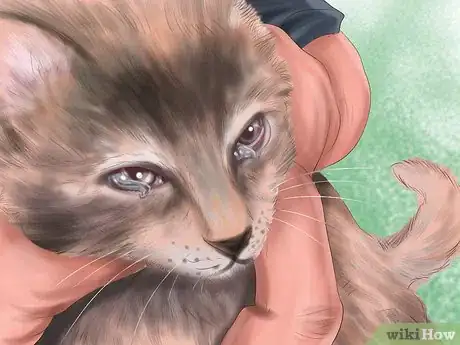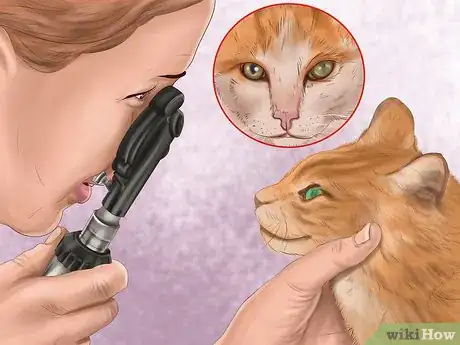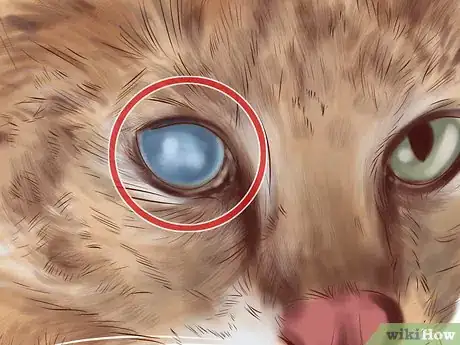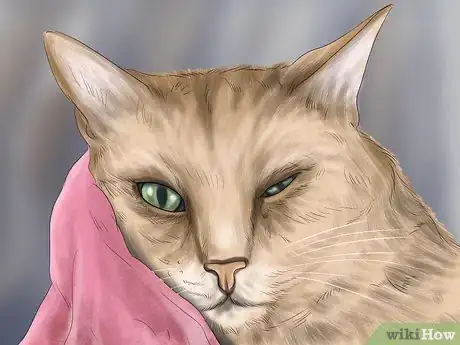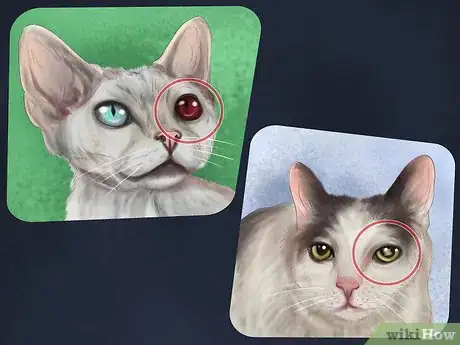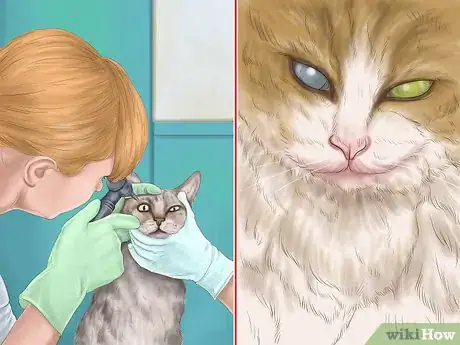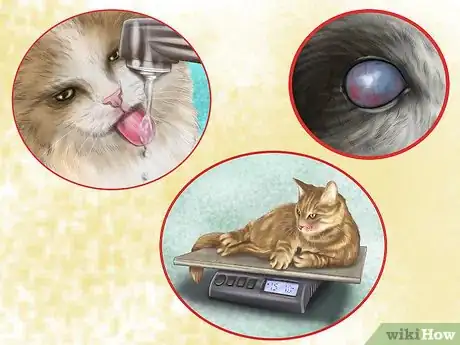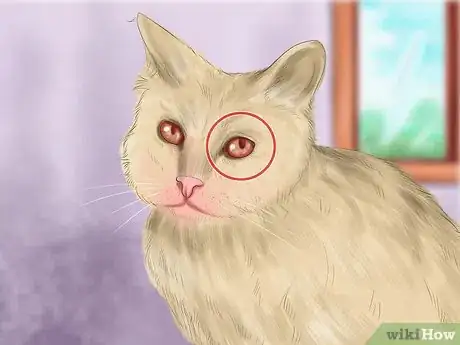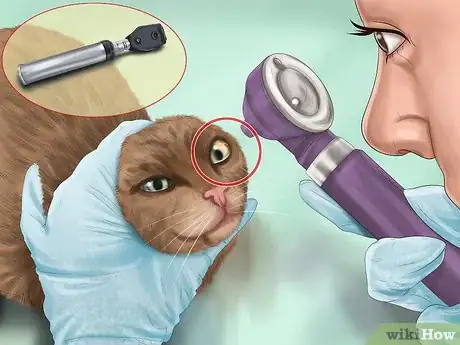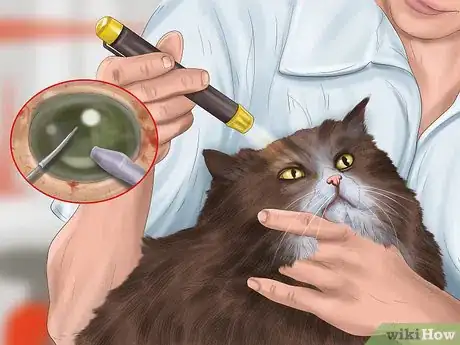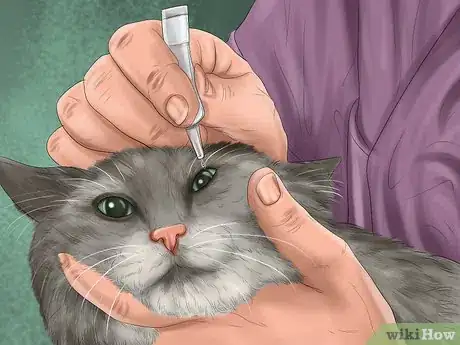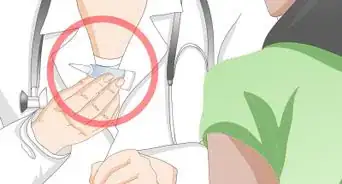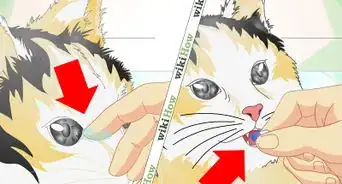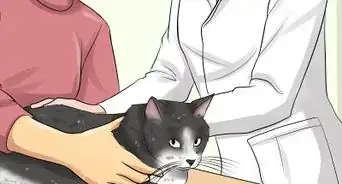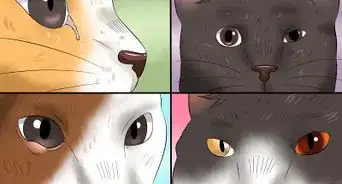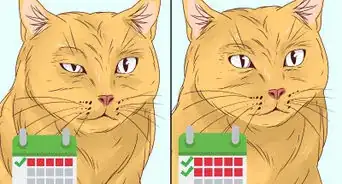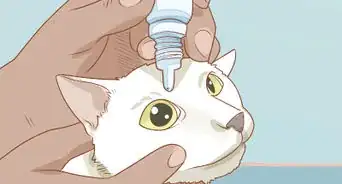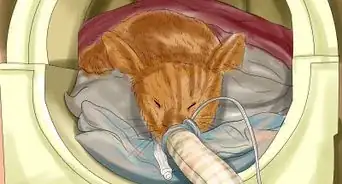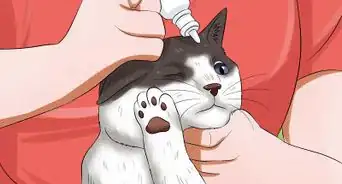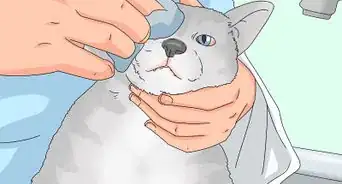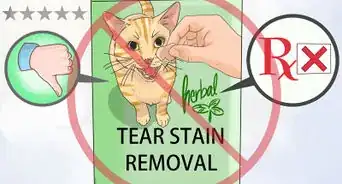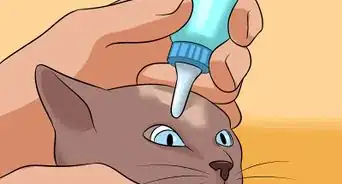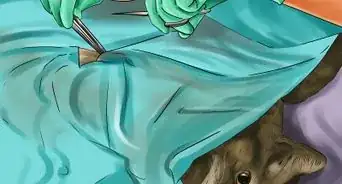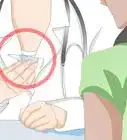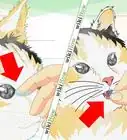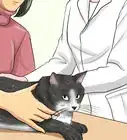This article was co-authored by Pippa Elliott, MRCVS and by wikiHow staff writer, Jessica Gibson. Dr. Elliott, BVMS, MRCVS is a veterinarian with over 30 years of experience in veterinary surgery and companion animal practice. She graduated from the University of Glasgow in 1987 with a degree in veterinary medicine and surgery. She has worked at the same animal clinic in her hometown for over 20 years.
This article has been viewed 41,080 times.
You've probably seen someone with cataracts, where the eye looks cloudy or milky. People, dogs, and cats can all develop this condition which affects the lens of the eye, although cats are less likely to get cataracts. The lens sits behind the iris in the eye, and changes shape in order to focus light waves on the photo sensitive part of the eye, the retina. If the lens becomes cloudy or milky with cataracts, the lens doesn't let light into the retina. This can cause vision problems in your cat, which is one of the most noticeable signs that your cat has cataracts.
Steps
Recognizing the Symptoms
-
1Monitor your cat's eyes. You should always pay close attention to any changes in your cat's eyes. Most cataracts for slowly, gradually spreading over the surface of the eye. The earlier you spot it, the more can be done for your cat. If your cat has an illness or injury, the cataract may spread rapidly.[1]
- If your cat is starting to lose her vision, her other senses will start to adjust in order to compensate. This might make it difficult to see any changes in her sight. But, you should still watch for signs that your cat is struggling to see.
-
2Look at your cat's eye color. At first, you may notice a slight white color or haze over the lens of your cat's eye(s). The longer your cat has a cataract, the whiter and denser it will look. Your cat might have a cataract in one or both eyes.
- Sometimes a cataract will have an intense blue spot in the center of the pupil. The spot might stay small or it can quickly expand to cover the pupil.
Advertisement -
3Watch for milky or cloudy eyes. These changes are an obvious sign of cataracts. Normally, the lens is clear so when you directly look at the pupil, it appears black. This is because you can see straight through to the back of the eye. But, if your cat's lens and pupil look milky or cloudy, she may have cataracts.[2]
- If you don't see milky or cloudy eyes, but notice that the eye color has changed, you should still have your cat examined by a vet.
-
4Look for squinting. If your cat is having trouble with her vision, you may notice her squinting. This symptom shows that she's trying to cope with failing vision.
- The loss of vision varies from cat to cat. Some cats only have mild vision problems, while others might become completely blind.
-
5Pay attention to your cat's behavior. If your cat has severe cataracts, she may lose her vision. You might notice this if she startles more easily, because she doesn't see you approach. Or, she might walk into objects that are put in her path. Your cat might seem clumsier than usual.
- Your cat may lose confidence and become withdrawn, because she fears not being able to cope in strange situations or defend herself from other pets.[3]
-
6Consider your cat's risk factors. Cataracts can form because of trauma to the eye, like a knock or blow. These can cause inflammation. Naturally occurring toxins can also build up in the lens which makes it turn cloudy white. This usually happens with conditions like diabetes. Cataracts can also be congenital or genetic, affecting your cat from birth.
- If your cat has another condition or infection that causes inflammation within the eye (like iritis, FeLV, FIV), she is more likely to get cataracts.
Getting a Medical Diagnosis
-
1Take your cat to the veterinarian. If you suspect your cat has cataracts, take her to the vet as soon as you can. Getting an early diagnosis usually means you'll have more treatment options available, like getting surgical therapy. Also, recognizing that your cat has impaired vision can help you take safety precautions.
- For example, a cat with cataracts should live indoors so she's not bothered by other cats or at risk of getting injured in a road traffic accident.
-
2Get your cat's eyes examined. The vet will do a thorough examination before looking at your cat's eyes. Your vet may start by standing back and looking at your cat's eyes in order to get an overall impression. The vet will check to see if the eyes are the same size and whether there's increased eye pressure (a sign of glaucoma).
- The vet will also take a history of any changes with your cat (like changes in thirst, weight, and behavior). This helps rule out other conditions that can affect vision, like diabetes.
-
3Look for red eye in your cat. The veterinarian will use an ophthalmoscope which is a lens with a light on it to examine your cat's eyes. The vet will stand back and shine the bright light in each eye to look for 'red eye.' 'Red eye' is similar to the reflection you get when you take a flash photograph and the flash reflects off the retina.
- If your cat has 'red eye', this means that the light has passed through the lens and isn't blocked by cataracts. Your cat may be affected by another condition.
-
4Look for a shadow on the retina. The veterinarian will also use an ophthalmoscope to look for a shadow on the retina. If your cat has a cataract, it will stop light from passing through the lens. This casts the shadow. The test is used to differentiate between a cataract and a cloudy lens caused by old age.
- A cloudy lens from old age still lets some light through, unlike cataracts which can blind the cat.
-
5Follow the vet's treatment recommendations. If your cat is young or the cataract is very mild, your vet may recommend leaving it alone to see if it improves on its own. If the cataract begins to affect your cat's vision, you may want a specialist vet ophthalmologist to surgically remove the cataract, although this can be expensive. Or, the specialist can use a ultrasonic waves to remove the cataract (phacoemulsion).
- If your cat is affected by a condition other than cataracts, the vet will treat any underlying eye inflammation before starting treatment for the other health issue (like diabetes).
-
6Consider treating your cat's pain. If your cat has cataracts, she may have some discomfort. Ask the veterinarian about giving her anti-inflammatory eye drops. Your vet might also want to give her nutritional supplements if she's developing cataracts because of nutritional deficiencies.
- If left untreated, the cataracts may cause blindness and pain, at which point the eye might need to be removed.
Expert Q&A
-
QuestionWhy are my cat's eyes cloudy?
 Pippa Elliott, MRCVSDr. Elliott, BVMS, MRCVS is a veterinarian with over 30 years of experience in veterinary surgery and companion animal practice. She graduated from the University of Glasgow in 1987 with a degree in veterinary medicine and surgery. She has worked at the same animal clinic in her hometown for over 20 years.
Pippa Elliott, MRCVSDr. Elliott, BVMS, MRCVS is a veterinarian with over 30 years of experience in veterinary surgery and companion animal practice. She graduated from the University of Glasgow in 1987 with a degree in veterinary medicine and surgery. She has worked at the same animal clinic in her hometown for over 20 years.
Veterinarian There are several possible reasons why eyes are cloudy. First look to see if it's the cornea that's misty, or if the cloudiness is within the eye. Causes include dry eye, glaucoma, long term irritation, a prolapsed lens, high blood pressure, or a cataract.
There are several possible reasons why eyes are cloudy. First look to see if it's the cornea that's misty, or if the cloudiness is within the eye. Causes include dry eye, glaucoma, long term irritation, a prolapsed lens, high blood pressure, or a cataract. -
QuestionAre cataracts in cats painful?
 Pippa Elliott, MRCVSDr. Elliott, BVMS, MRCVS is a veterinarian with over 30 years of experience in veterinary surgery and companion animal practice. She graduated from the University of Glasgow in 1987 with a degree in veterinary medicine and surgery. She has worked at the same animal clinic in her hometown for over 20 years.
Pippa Elliott, MRCVSDr. Elliott, BVMS, MRCVS is a veterinarian with over 30 years of experience in veterinary surgery and companion animal practice. She graduated from the University of Glasgow in 1987 with a degree in veterinary medicine and surgery. She has worked at the same animal clinic in her hometown for over 20 years.
Veterinarian Cataracts are not painful; however, they do interfere with vision. A cataract is a cloudy lens, so light can't pass through to react with the retina. Thus, the cat is not in pain but may be confused or disorientated at times.
Cataracts are not painful; however, they do interfere with vision. A cataract is a cloudy lens, so light can't pass through to react with the retina. Thus, the cat is not in pain but may be confused or disorientated at times. -
QuestionHow can I tell if my cat has vision problems?
 Pippa Elliott, MRCVSDr. Elliott, BVMS, MRCVS is a veterinarian with over 30 years of experience in veterinary surgery and companion animal practice. She graduated from the University of Glasgow in 1987 with a degree in veterinary medicine and surgery. She has worked at the same animal clinic in her hometown for over 20 years.
Pippa Elliott, MRCVSDr. Elliott, BVMS, MRCVS is a veterinarian with over 30 years of experience in veterinary surgery and companion animal practice. She graduated from the University of Glasgow in 1987 with a degree in veterinary medicine and surgery. She has worked at the same animal clinic in her hometown for over 20 years.
Veterinarian Try flicking your finger quickly towards the eye. This is known as the "menace reflex" because the normal reaction is to blink when something threatens the eye. If the cat can see, they should blink. However, be careful not to touch the whiskers as this will also make the cat blink.
Try flicking your finger quickly towards the eye. This is known as the "menace reflex" because the normal reaction is to blink when something threatens the eye. If the cat can see, they should blink. However, be careful not to touch the whiskers as this will also make the cat blink.
References
About This Article
To determine if your cat has cataracts, monitor your cat’s eyes for any changes, especially if they develop a slight white color or haze over the lenses. You should also watch your cat’s behaviors and take note if it starts squinting or bumping into things around the house because it might be coping with vision loss. If you notice any of these signs, you can help your cat get the care it needs by taking it to the vet for an evaluation. Your cat might also have a number of risk factors that make it more likely for it to develop cataracts, so take extra care if your cat has had a blow to the eye, or has a condition like diabetes, which can cause naturally occurring toxins to build up in the lens of the eye. For more help from our Veterinary co-author, like how to treat your cat’s discomfort from cataracts, scroll down.
